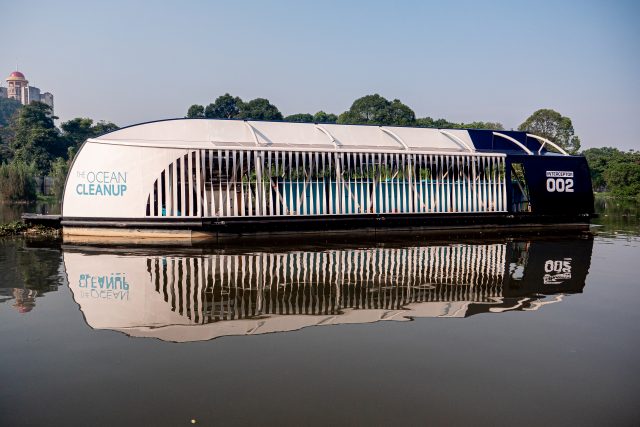- About
- Topics
- Picks
- Audio
- Story
- In-Depth
- Opinion
- News
- Donate
-
Signup for our newsletterOur Editors' Best Picks.Send
Read, Debate: Engage.
| June 05, 2018 | |
|---|---|
| topic: | Ocean Pollution |
| tags: | #Waste Management, #plastic seeps, #Arctic Ice, #sustainable fashion, #regenerated yarns |
| located: | United Kingdom |
By Maddy White
Every year 12.7 million tonnes of plastic seeps its way into the oceans, with some of it even getting trapped in the Arctic ice, lodged in the bellies of marine life and caught around turtle’s necks. As a result, many fashion brands are taking this as an opportunity to incorporate regenerated yarns into their collections. But is this a sustainable future for fashion and our planet?
Technology and fashion have merged to produce Bionic and Econyl yarns, which are being made from discarded plastic in the oceans. From water bottles to takeaway containers and even old fishing nets, it seems fashion has repurposed plastic firmly on its agenda. This plastic is being recycled into usable yarns for the creation of garments like trainers, sportswear, lingerie and even dresses.
These yarns are increasingly being used by local and global brands to create all types of textile products. Not only is this integration removing plastic from the oceans and reusing it but it's also helping to improve local communities. Two years ago twelve tonnes of abandoned fishing nets were collected from the Basque region and turned into Econyl yarn; this is still being utilised today, forming part of clothing brand Ternua's autumn-winter 2018 collection.
But there are problems with repurposing plastic into garments. When any synthetic clothing is washed, tiny plastic fibres can be released from the fabrics and these microplastics can make their way into water systems. According to Mark Anthony Browne in Environmental Science & Technology, one single synthetic garment can produce nearly 2,000 microfibers per wash. As of July 2018, these microplastics—which are comparable to cosmetic beads—are going to be banned from sale in the U.K. because of the threat they pose to marine life as they find their way into food chains and cause serious harm to aquatic life. At the same time, the microscopic dimensions of these plastics mean they cannot always be filtered by sewage systems, proving a real concern to the environment.
At the moment, fashion made from synthetic material is inevitable, it is and will be used to make throwaway fashion for the foreseeable future. The most common synthetic textile is polyethylene terephthalate (polyester), a plastic produced from crude oil and also used to create many other household items, from hosepipes to ketchup bottles. It is predicted that more than 98 percent of fiber production in the future will be synthetics, and of this, 95 percent will be polyester. Sure, repurposing old plastic is better than producing more. Yet a more long term solution would be to encourage the fashion industry to further push towards making garments from sustainable sources that will not prolong harmful effects on the environment.
Two fashion students in Delaware have created biodegradable shoes using a part of a mushroom called the mycelium, chicken feathers and textile waste. It is local innovation like this that will lead the fashion industry. Jillian Silverman, co-maker of these shoes said to Screen Shot, “Mycelium has been used in hard structures like packaging and insulation, and our proximity to the mushroom farms in Kennett Square, Pennsylvania, provided us with a great local material input.”
Aside from fabrics, there are other factors in making fashion entirely sustainable, especially for larger brands. Silverman continued, “The textile industry needs more sustainable production methods, materials, and end of life considerations; mycelium shoe sole can be produced with minimal energy, is non-toxic and safe to work with and wear, and can safely break down when it is no longer useful. Plenty of other bio-based materials offer similar benefits, and this sort of innovation is crucial to improving the apparel and footwear industries.”
The concept of producing clothing from yarns made from regenerated ocean plastic, in theory, is a revolutionary idea, but the repercussions that result from washing synthetic fabrics does not actually improve the environmental problem of microplastics. Plastic conscious clothing is appealing to customers who are becoming more aware of environmental impacts but this cannot be seen as the final goal of the sustainable fashion trend. If synthetic clothing is an essential part of the fashion industry (and it shouldn’t be), then using old plastic that is polluting the sea is certainly better than creating more. Yet, ideally, fashion would look to use only sustainable and biodegradable fabrics to create garments like Silverman’s project and only when this happens—and other impacts like waste reduction, manufacturing practises and human impacts are improved—can fashion be praised for a lesser impact on the environment.
This article was first published in
By copying the embed code below, you agree to adhere to our republishing guidelines.
